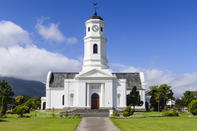Gateway to the Garden Route
George was the first town founded by the British after their second invasion of the Cape in 1806. Prior to this, the Dutch had already shown interest in establishing a new administrative district further East from Swellendam, and the first British governor of the Cape, the Earl of Caledon, concurred.

The town was established in 1811, and named after the ruling British king, George III. George served as a woodcutter’s outpost who supplied timber to the Cape Colony for many years. Initially, the town grew slowly, partly due to the lack of accessible roads through the Outeniqua Mountains. When the Outeniqua Pass opened in 1847, inland trade could develop and George began to flourish.
It’s situated about 10 km inland and, if you want to swim in the sea, the closest bathing spots are the tidal pool of Herolds Bay, or at the stunning beach of Victoria Bay. Still, George has a nice setting at the foot of the Outeniqua Mountains, and it is a historical town with its fair share of attractions.
The old town centre of George is dominated by a huge Oak Tree. This is where the British used to hold the slave auctions, and an old iron chain is still embedded in the tree’s wizened trunk. The Tourism office is opposite the slave tree, and the museum (housed in the old Drostdy) is across the road.
The holy trinity (Anglican, Catholic and NG Kerk) all have excellent architectural representation, and the tiny Anglican cathedral of St. Marks is the cornerstone of George’s city status. Although, technically, the Garden Route region starts at the mouth of the Breede River near Mossel Bay, George is commonly acknowledged as the gateway to the Garden Route.
George is also the region’s industrial and shopping headquarters. All the major retail chains are represented in one of several bland commercial developments, and George is a good place to stock up on those hard-to-get supplies before plunging into the smaller towns ahead.
By David Fleminger As George is the 6th oldest town in the country, it boasts numerous historical buildings, with some dating back to the early 1800s. Many of ...
As George is the 6th oldest town in the country, it boasts numerous historical buildings, with some dating back to the early 1800s. Many of ...